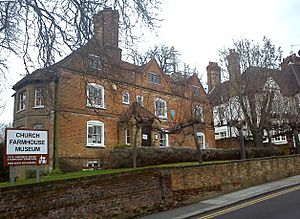Church Farmhouse Museum facts for kids
The Church Farmhouse Museum was once a special place in Hendon, north London. It was located in a very old farmhouse, built in the 1600s! This building is the oldest house still standing in Hendon. It's so important that it's called a Grade II* listed building. This means it's a building of special historical interest.
Contents
A Glimpse into the Past
What Was Inside?
The museum showed how people lived long ago. It had rooms set up like they were in the past, including a kitchen and a scullery (a small room for washing dishes). There were also two areas for special exhibitions. Outside, the museum had a large garden with a pond.
The Old Farmhouse Itself
The farmhouse is a two-story building made of red bricks. It has three pointed sections on the roof called gables. Chimneys are placed in the middle of the roof. This style of building was very common in the 1600s in Middlesex, which is an old county in England. It shows how people built houses back then.
Famous People Who Lived Here
A special blue plaque on the house tells us that Mark Lemon lived there. He was a famous writer and the first editor of Punch magazine. Mark Lemon lived in the house as a child between 1817 and 1823. He even wrote about his childhood memories in the area in his book, Tom Moody’s Tales.
The Kempe family owned the house for many years, from 1688 to 1780. Later, the Dunlop family lived there from 1869 to 1945.
Why the Museum Closed
Council Decisions
In 2010, the Barnet Council decided to stop giving money to the Church Farmhouse Museum. They also stopped funding Barnet Museum. This decision was made to save money, even though many local people did not agree with it.
Public Opinion
The council asked the public what they thought about the plan. This is called a public consultation. Many people were against the closure. Two petitions were created, and about 2,900 people signed them, asking the council to keep the museum open.
The Final Closure
Despite the public's wishes, the council decided to go ahead with their plan. The Church Farmhouse Museum closed its doors on March 31, 2011. The very last special exhibition, which was about Harry Beck and the London Tube Map, ended a few days before, on March 27, 2011.
What Happened Next
The Museum's Collection
After the museum closed, its collection of historical items was divided. Some pieces were moved to Barnet Museum. Other items were sold at an auction.
The Building Today
The old farmhouse found a new purpose. In 2016, Middlesex University took over the building and carefully restored it. Today, the building is used by two important centers: the Centre for Abuse and Trauma Studies and the European Human Rights Advocacy Centre. Both of these are part of Middlesex University.


